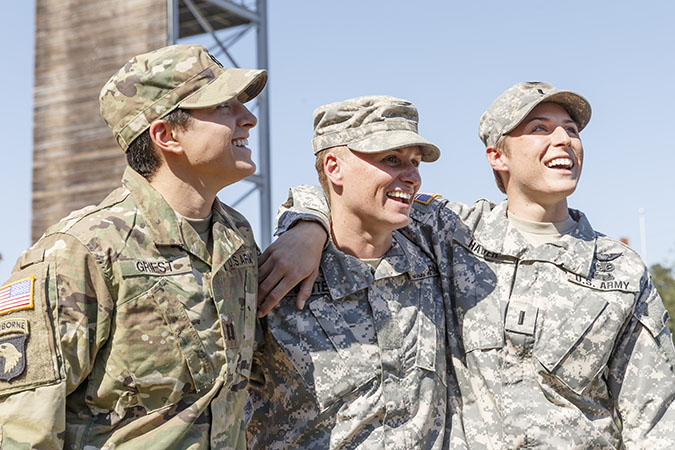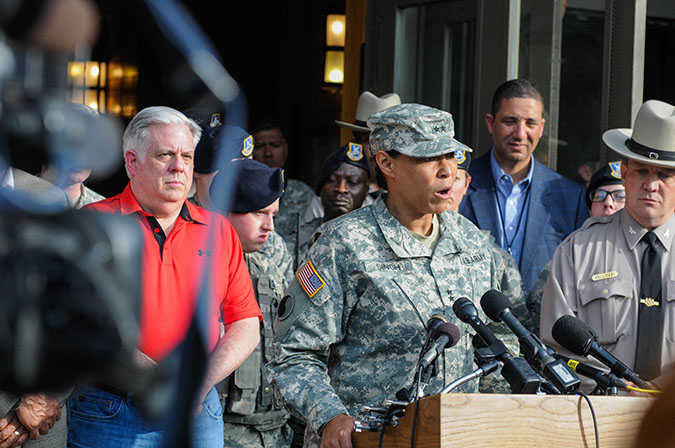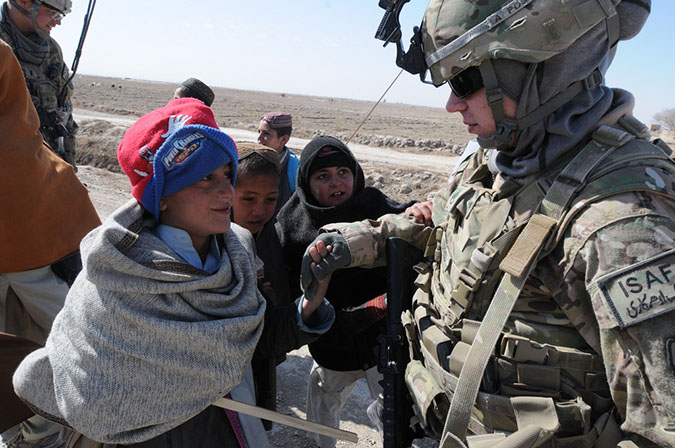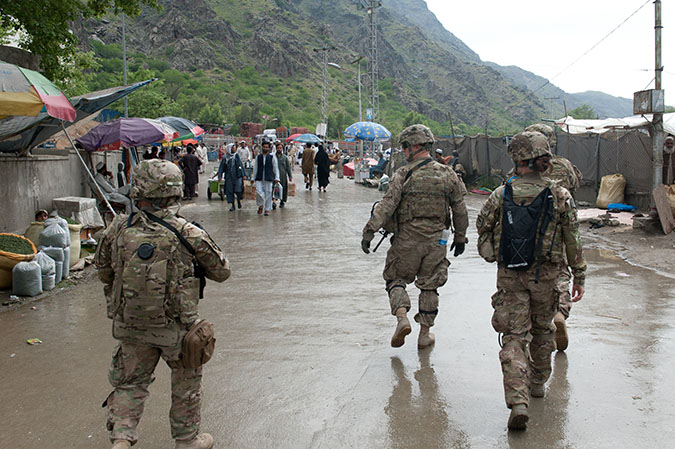Commentary: Gender matters, but not why you might think
[vc_row][vc_column][vc_column_text]
By Staff Sgt. Margaret Taylor, 29th Mobile Public Affairs Detachment—
“They must have lowered the standards.”
We were talking about the two women who had just completed Army Ranger School, and my brother Tim was playing devil’s advocate.
Even knowing that he was only parroting a common negative opinion and it wasn’t his own, I got huffy.
I sputtered something about Ranger pride and the probability that some girl out there had to be capable enough to beat the challenge.

U.S. Army Reserve Maj. Lisa Jaster, center, became the third woman to graduate from the U.S. Army’s elite Ranger School, Oct. 16, 2015, in Fort Benning, Ga. Jaster, 37, joins just two other women, Capt. Kristen Griest, 26, left, and 1st Lt. Shaye Haver, 25, right, in gaining the coveted Ranger tab. (Paul Abell / AP Images for U.S. Army Reserve)
Our conversation became a bit more civil after that, but something about it has stuck with me in the months since.
I read a lot of the news reports that covered the story of Capt. Kristen Griest and 1st Lt. Shaye Haver – and later Maj. Lisa Jaster – earning their Ranger tabs, all the while looking for something that was missing.
Was it all about checking the equal opportunity block? To public perception, maybe Griest, Shaye, and Jaster’s achievement wasn’t much more than that.
But I believe public perception completely missed what’s at stake.
Gender, in and of itself, does not matter.
“Blasphemy!” some might say. “Sexism! Misogyny!”
And I’d say, “What’s the point of gender integration? To fill a quota? To add a dash of pink into a sea of blue? I don’t want to be reduced to my chromosomes any more than any other person does.”

Maryland Gov. Larry Hogan eats dinner with a few members of the Maryland National Guard and afterwards gives a press conference along with the adjutant general of Maryland, Maj. Gen. Linda L. Singh, in front of the 5th Regiment Armory in Baltimore, Md., April 29, 2015. (Photo by Staff Sgt. Michael E. Davis Jr., Maryland National Guard Public Affairs Office)
“Of course you shouldn’t!” they’d say. “A person’s value in an organization exceeds her genetic makeup: her experiences, her education, her upbringing – which are unavoidably linked to her gender and race – all contribute. That’s why equal opportunity is not only just, but practical too.
Barring a person from a position on account of gender means we lose the potential benefits of all the rest.”
“So, from that viewpoint, going with the ‘same-old, same-old’ all the time would be a bad thing,” I’d say.
“Sure. Bringing in people with different points of reference means we can tackle problems that arise with fresh perspectives. Diversity in the ranks means a more robust fighting force or workforce.”
Huh. Diversity.
I’ve heard the word thrown about a lot, most particularly in regard to the Army Equal Opportunity Program. Looking around, though, I discovered that Army EO doesn’t have a monopoly on the term.
For instance, in finance diversified portfolios cut the happiest medium between profit growth and security. In architecture, bricks run in alternating patterns, which adds strength as well as curb appeal. In biology, inbreeding results in freaky future generations. In military tactics, engaging the enemy with plans that are the ‘same-old, same-old’ is a recipe for disaster.

U.S. Army Staff Sgt. Nikita Zarelli, a member of the Female Engagement Team for C Troop, 5th Squadron, 1st Cavalry Regiment, 1st Stryker Brigade Combat Team, 25th Infantry Division, talks with a group of local Afghan children on their way to school in the Dand district, Kandahar province, Afghanistan, Feb. 9.
Even if the word has been overused and abused, I think diversity’s value shouldn’t be ignored.
Looking back to February, the Maryland National Guard got its first African-American woman as adjutant general. Maj. Gen. Linda L. Singh wasn’t given command on account of her race or gender or to score EO kudos, but those were the focus of nearly every story.
Then the civil unrest in Baltimore happened in late April, and the Maryland Guard was activated to assist.
When Singh stepped in front of the cameras, maybe her gender and skin color first caught people’s attention. But she held their attention when she shared the wisdom gained from her background, her experiences and the decisions she’d made to get to the top. All of that – every little bit – allowed her to speak words that resonated, that connected with people in Baltimore.
Singh was the right person for the job, no question about it.
That’s why I think gender matters, especially in today’s military. It can’t be just a quota or ratio. Rather, it’s an element that when – and only when – taken with all the other things that make up an individual, can strengthen and add depth to a group. This is the purest, most valuable form of diversity.
While the ‘same-old, same-old’ can stunt development, I think cultivating such valuable diversity can ultimately enrich the military environment.

U.S. Army Soldiers from 327th Infantry Regiment, 101st Airborne (Air Assault) Division assist Afghan forces secure the customs checkpoint at Torkham Gate, Afghanistan, April 24, 2013. Though women are still not yet fully integrated into combat units, women are not absent from the frontlines. Many fields in the Army, such as public affairs or linguistics, send women to the front where they embed with line units and share the risk. (Photo by U.S. Army National Guard Spc. Margaret Taylor, 129th Mobile Public Affairs Detachment)
[/vc_column_text][/vc_column][/vc_row]
